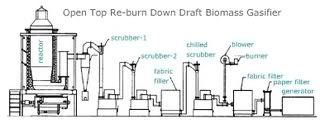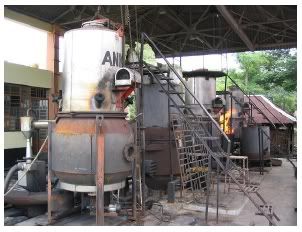Biomass gasification to power rural India out of energy poverty
 Energy experts and development economists understand the detrimental socio-economic effects of the lack of access to modern energy in the developing world. Half the world's population lives in rural areas, where more than 2 billion people are not connected to the grid. Taking electricity from the central power grid to bring it to these isolated communities is costly and unreliable because of heavy transmission losses and poor load demand.
Energy experts and development economists understand the detrimental socio-economic effects of the lack of access to modern energy in the developing world. Half the world's population lives in rural areas, where more than 2 billion people are not connected to the grid. Taking electricity from the central power grid to bring it to these isolated communities is costly and unreliable because of heavy transmission losses and poor load demand.The consequences of this situation perpetuate a disastrous cycle: lack of access to electricity sustains poverty, which in turn condemns people to rely on time-consuming and primitive forms of energy (dung, fuel wood), which results in environmental degradation, low economic (agricultura) productivity and further poverty; poverty is in turn correlated with increased fertility, which fuels a population increase that results in even more pressures on the environment, and ultimately to ever deeper poverty... Neither the State nor the private sector sees the poor as viable consumers worth the investments needed for rural electrification. And so the cycle perpetuates itself.
Amongst many organisations, the International Energy Agency and the World Energy Council studied the matter in depth and found a very strong positive correlation between underdevelopment and lack of access to energy (the UN's Human Development Index and the IEA's Energy Development Index neatly overlap). For this reason, addressing the question of rural energy poverty is crucial to achieve the Millenium Development Goals.
Even though there is no magic solution to the age-old development problem of bringing electricity to the rural poor, some elements and factors have been identified as key: decentralisation, reliance on locally available energy resources (water, wind, the sun or biomass) and, crucially, the need for low-cost systems.
Biomass gasification - the way out?
Experts from India think these principles and requirements converge in a technology known as biomass gasification, in an electrification concept that has become commercially feasible and reliable (in-depth discussion of the technology, here, or see the image showing a downdraft biomass gasifier, click to enlarge). The energy system may be applicable to rural areas in the developing world at large because it is the least costly of the common alternatives. Depending on local circumstances, it is estimated to be between 15 and 20 times less costly than photovoltaics.
Several community-operated experiments with decentralised biomass gasification and electrification are now underway in India, and it looks like the technology can literally turn marginalised communities into thriving and prosperous societies (see the case-study below). Drawing on this success, an ambitious initiative by science institutes and the private sector has been launched aimed at mass-producing efficient small to medium-scale gasifiers:
 bioenergy :: biofuels :: energy :: sustainability :: energy poverty :: rural development :: electrification :: decentralisation :: biomass :: gasification ::
bioenergy :: biofuels :: energy :: sustainability :: energy poverty :: rural development :: electrification :: decentralisation :: biomass :: gasification :: India's rural settlements produce an abundance of agricultural waste streams, such as bagasse, rice and wheat straw. Indian researchers estimate that the energy contained in these resources is sufficient to meet all the energy needs of India's rural population with capacity left to grow.
According to the country's Ministry of Non-Conventional Energy Sources (MNES), there is more than 1,700 MW potential for producing gas from biomass, including agricultural residues, enough to power the 125,000 villages that are yet to be electrified.
Biomass gassification technology, which has been around for more than three decades, now has proved to be a cost effective, ecofriendly system to meet the rural energy requirements. In fact, biomass gasification, a process that results in 'producer gas' — a mixture of carbon monoxide, methane, hydrogen and carbon dioxide - is already picking up in India as a major alternative energy source.
Case study: cooperatives in the Sunderban area of West Bengal
 Hitofumi Abe did fieldwork [*.pdf] for the Japan International Cooperation Agency, and research current biomass gasification projects in India. He was surprised to find very positive outcomes of the system. One of his case-studies focused on a pilot plant operated by a rural cooperative on Gosaba Island in the Sunderbans. The farmers' success was soon replicated by other communities.
Hitofumi Abe did fieldwork [*.pdf] for the Japan International Cooperation Agency, and research current biomass gasification projects in India. He was surprised to find very positive outcomes of the system. One of his case-studies focused on a pilot plant operated by a rural cooperative on Gosaba Island in the Sunderbans. The farmers' success was soon replicated by other communities.About three million people inhabit the Delta Region of Sunderbans, West Bengal State. Two million of them do not have access to electricity. It is not economically feasible to extend grids to many islands wide spreaded in the Delta Region. The 500 kW (5 x 100 kW) biomass gasifier duel fuel power generation system (70% biomass + 30% diesel) was installed at Gosaba Island, Sunderbans in June, 1997. Gosaba Island located about 80 km south west of Kolkata. It takes 1.5 hours by boat from the nearest port of mainland. There were only 16 customers when the operation started because people did not believe the system really works. But the customer base increased very quickly and currently 1150 households are connected. The plant is operating 15 hours a day (10:00 am to 1:00 am next day).
The island developed dramatically since the power station was installed. There are many new commercial stores and more than 10 hotels, and people from near by islands come to Gosaba for shopping. A bank (State of India Bank) opened and supports economical activities. A telecommunication system has opened its doors, internet is now available and there is a PC training centre. The hospital can now conduct basic operations. The electricity is also used for public purposes such as street lights, school lighting, drinking water supply and irrigation.
The project is 100% funded by government since this is a pilot project but it is operated by the Gosaba Rural Energy Cooperative. The cooperative owns a 75 hectare energy plantation. Biomass fuel is supplied by both from farmers and the plantation.
Drawing on the success of this pilot program, another 500 kW biomass gasifier duel fuel power generation system was commissioned in the remote Island of Chhotomollakhali in the Sunderbans in June 2001. Since then, numerous smaller-scale biomass gasifier electrification units has been installed in West Bengal State.
New efficient gasifier systems of a slightly larger scale are under development that use the waste heat from the unit, resulting in efficient co-generation concepts. Co-generation is feasible in the sugar industry, rice mills as well as paper and textile mills. For instance, by upgrading the steam generation capacity of sugar mills, steam produced in excess of their process heat requirement can be utilised for power generation.
Mass production of gasifiers
Meanwhile, in a development of significance Cummins India and the Bangalore-based Indian Institute of Science (IISc) have gone in for commercial tieup aimed at promoting the biomass gassification system designed and developed by IISc. According to Prof P.J. Paul of IISc who is one of the architects of this biomass gasification system, “our technology package known as Open Top Reburn Downdraft biomass gasifier generates gas from a range of biomass that comprises forest residues and agricultural wastes" (earlier post). Indeed, as pointed by Paul, the cost of energy generated through biomass is reduced substantially through the gassification route.
Pampraveen Swaminathan, Vice-President of power generation business at Cummins India, drives home the point that the biomass gassification provides a significant life cycle cost advantage over hydrocarbon and ultimately leads to the development of a sustainable energy system.
It has been estimated that biomass gasification generates 1 MW of power at around 20 to 30 million rupiah (€353,000/US$481,000 to €530,000/US$721,000). Solar energy costs between 15 and 20 times more, at about 350 to 400 million rupiah (€6.2/US$8.4 to €7/US$9.6 million) per MW .
India’s first community based biomass gasifier power plant at Kabbigere, 30 km from Tumkur in the state of Karnataka, is generating 0.5 MW of power to feed the central power grid and ensure round the clock, reliable power supply to five villages for both irrigation and domestic purposes.
Vast potential
As pointed out by Anil K. Rajvanshi of Nimbalkar Agricultural Research Institute (NARI), which operates a biomass gassification plant working on agricultural residues such as sugarcane leaves and wheat straw, India produces an estimated 600 million tonnes of agricultural residue per year.
He points out that if all this waste were to be gasified in the latest generation of gasifiers, it can produce a total of 79,000 MW of power — about 60 per cent of the total power available in the country. Rajvanshi thinks “it is feasible to set up a biomass based power plant of 10-20 MW capacity to cater to the needs of about 100 villages. In this way rural energy needs in India can be fully well met.”
Image: 5 x 100 kW biomass gasifier at Gosaba Rural Energy Cooperative, West Bengal State. Courtesy: Hitofumi Abe.
More information:
Tribune India (Radhakrishna Rao): Biomass gasification - April 20, 2007.
World Energy Council: The challenge of rural energy poverty in developing countries - s.d., a basic introduction.
International Energy Agency: Energy and Development [*.pdf] (Chapter 10 of the IEA's World Energy Outlook 2004), which contains the Energy Development Index.
International Energy Agency: Biomass and the Millenium Development Goals - 2006.
Hitofumi Abe, Summary of Biomass Power Generation in India [*.pdf] - Ecosystem Research Group, University of Western Australia, October 2005.
Andreas Gantenbein, "Validation Report of a Greenhouse Gas Mitigation Biomass Gasifier Power Plant Project in the north-Indian State of Bihar" [*.pdf] - Centre for Energy Policies and Economics (CEPE), Department of Environmental Sciences (D-UWIS), Swiss Federal Institute of Technology (ETH), Zurich, October 2005.
 --------------
--------------
 Scientists working for Royal Nedalco (involved in cellulosic ethanol production), the Delft University of Technology and a firm called Bird Engineering have found a fungus in elephant dung that helped them produce a yeast strain which can efficiently ferment xylose into ethanol. The researchers consider this to be a breakthrough and see widespread application of the yeast within 5 years. More info to follow as details emerge.
Scientists working for Royal Nedalco (involved in cellulosic ethanol production), the Delft University of Technology and a firm called Bird Engineering have found a fungus in elephant dung that helped them produce a yeast strain which can efficiently ferment xylose into ethanol. The researchers consider this to be a breakthrough and see widespread application of the yeast within 5 years. More info to follow as details emerge.








0 Comments:
Post a Comment
Links to this post:
Create a Link
<< Home